Key Points
- The study, led by Dr. Lucy Semerjian, analyzed ten metals in 52 wet and dry cat food samples sold in Sharjah, UAE, highlighting a lack of regional data on pet food safety and contributing to the broader One Health framework linking animal, human, and environmental health.
- While 70% of the samples complied with U.S. and European standards, 30% exceeded limits for essential metals like zinc, copper, iron, and manganese.
- Dry cat foods generally had higher metal concentrations due to low moisture content, fortified mineral premixes, and high-heat processing. Metal levels also varied by protein source, with red meat–based foods containing more metals than fish- or chicken-based ones.
A recent study conducted in the Journal of Food Composition and Analysis examined the concentrations of ten metals in 52 commercially available wet and dry cat food samples, assessing their compliance with U.S. and European pet food safety standards (1). The lead author of this study, Lucy Semerjian, recently sat down with Spectroscopy to discuss the findings of her study.
Semerjian is the Chair and Associate Professor in the Department of Environmental Health Science at the University of Sharjah in Sharjah, United Arab Emirates. She has published 65 papers throughout her career. Her expertise includes water and wastewater treatment, environmental pollution control, ecotoxicological risk assessment, and analytical chemistry (2).
In Part I of our two-part conversation with Semerjian, she discusses several key aspects of her study, including the differences in metal content between wet and dry pet foods.
Can you provide a brief overview of pet ownership in the United Arab Emirates (UAE)? What prompted your team to investigate metal concentrations specifically in cat foods marketed in Sharjah, and how does this local focus contribute to the global conversation on pet food safety?
Pet ownership in the UAE, particularly in urban settings like Sharjah, has grown significantly in recent years. As more residents, both locals and expatriates, embrace companion animals, there has been a corresponding rise in the demand for commercial pet foods. Cats are especially popular in the region because of cultural preferences, the prevalence of stray populations, and the adaptability of cats to apartment living.
Although global studies exist on this subject, there is limited availability of data on metals in pet food within the Gulf Cooperation Council (GCC), including the UAE. Moreover, understanding environmental factors in this region, particularly in the UAE, is crucial for assessing localized risks. Thus, this study is essential in addressing the existing knowledge gap, aiming to contribute valuable information for regulatory authorities, pet food manufacturers, and pet owners. Our findings not only aid in understanding the potential risks associated with metal contamination in pet food, but they also guide the development of strategies to ensure the well-being of pets. Animal health is a significant arm of the One Health concept, and it is closely linked with human health and environmental health.
Your results showed that 70% of the cat food samples met international regulatory standards. For the remaining 30%, what metals exceeded the limits, and what potential health risks do these pose to pets?
As reported for the total of 52 cat food samples investigated in this study, most samples (70%) met international regulatory standards (that is, United States Food and Drug Administration [USFDA], and Fédération Européenne de l’Industrie des Aliments pour Animaux Familiers [FEDIAF]). Three samples exceeded limits for aluminum and copper, two for cobalt, iron, and manganese, and four samples for zinc. As evident, exceedances are mostly for essential metals such as zinc, copper, iron, and manganese, while less prevalent for trace toxic metals such as aluminum and cobalt. Although metals play a crucial role in the overall well-being of pets as they are essential components for various biological functions, prolonged exposure to elevated metal levels may lead to various health problems, including kidney damage, neurological issues, cardiovascular problems, and gastrointestinal disorders. In particular, pets with compromised organ function and small animals are more susceptible to metal toxicity because of their body size and metabolism.
Dry foods were found to have significantly higher concentrations of most metals compared to wet foods. What factors might contribute to this difference, and how should pet owners interpret this when choosing food for their cats?
Our study observations with dry pet foods containing significantly higher concentrations of most metals than wet foods are consistent with findings from several international studies. Indeed, there are multiple reasons behind this difference, and understanding them can help pet owners make more informed choices.
Dry pet foods typically exhibit higher metal concentrations because of their low moisture content (8–10%) compared to 70–80% in wet foods, resulting in higher concentration of all nutrients per unit of weight, including metals. In addition, dry pet food formulations often rely heavily on fortified mineral premixes to meet nutritional standards. These premixes may contain metals such as zinc, copper, manganese, or iron, at times exceeding necessary levels. Processing and heat treatment used in manufacturing dry pet foods involve high temperatures and pressure, which can increase the bioavailability of metals or even lead to contamination from machinery or packaging materials. Moreover, many dry foods use grains, legumes, and vegetable by-products, which may naturally accumulate metals from the soil or water used during cultivation. Dry foods may contain preservatives or additives to extend their shelf life which also introduce trace elements. Last, long storage times of dry food might lead to gradual metal leaching from packaging, especially in hot climates, as in the case of the UAE.
Implications to pet owners when choosing food for their cats may include moderation and rotation between dry and wet foods and among different protein sources to minimize potential cumulative exposure to higher metal levels found in specific formulations, look for compliant labels, and choosing well-regulated, reputable brands, and considering individual health needs of their cats. Also, pet owners should be aware of nutrient density versus toxicity risks, whereby a higher concentration of metals is not necessarily harmful. Many metals are essential micronutrients (for example, iron, zinc, and copper), but excessive or prolonged exposure, especially to non-essential or toxic metals like lead, mercury, or cadmium, can pose health risks over time.
The study also examined the relationship between protein sources and metal content. Could you elaborate on why some meat-based foods tend to have higher metal concentrations than fish- or chicken-based ones?
The relationship between protein sources and metal concentrations in pet food is an important aspect of food safety and nutrition. Thus, it is recommended to rotate protein sources to balance nutritional benefits and minimize prolonged exposure to any one type of metal. Meat-based pet foods may contain higher levels of certain metals compared to those based on fish or chicken as red meats (for example, beef, lamb, and liver) naturally contain higher levels of essential metals like iron, zinc, and copper partly because these animals have larger muscle mass and blood volume, increasing heme-iron and associated metals. Additionally, organs like the liver and kidneys, common ingredients in meat-based pet food, store both essential and toxic metals. In contrast, chicken and fish typically contain lower concentrations of these metals per gram of protein. Source of the animal and its diet also play a role, as farmed livestock may be exposed to metal supplements in feed, or to environmental contaminants such as lead or arsenic from soil or water sources. Some fish, depending on their environment, may also have elevated mercury or arsenic, but many commercial fish-based pet foods use small pelagic species like sardines or anchovies, which tend to have lower mercury levels than large predatory fish.
In the second part of this two-part interview that will be published tomorrow, Semerjian will discuss the role that inductively coupled plasma–optical emission spectroscopy (ICP-OES) played in her study, as well as how regulatory frameworks account for chronic exposure to low levels of metals in pet food.
References
- Semerjian, L.; Alsuwaidi, S. M.; Alhosani, M. K.; et al. Quantification of Metals in Commercially Available Wet and Dry Cat Food in United Arab Emirates. J. Food Comp. Anal. 2025, 140, 107249. DOI: 10.1016/j.jfca.2025.107249
- University of Sharjah, Dr. Lucy Semerjian. Sharjah.ac.ae. Available at: https://www.sharjah.ac.ae/Academics/Faculty-And-Staff/Lucy-Semerjian (accessed 2025-06-10).






